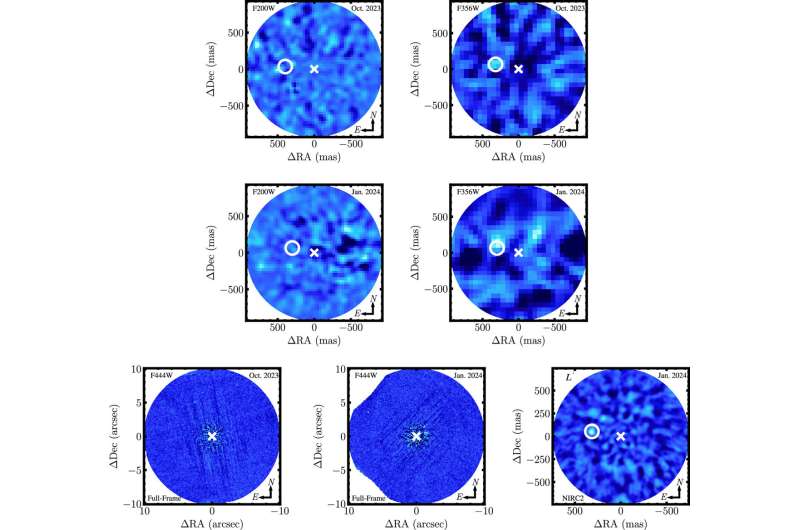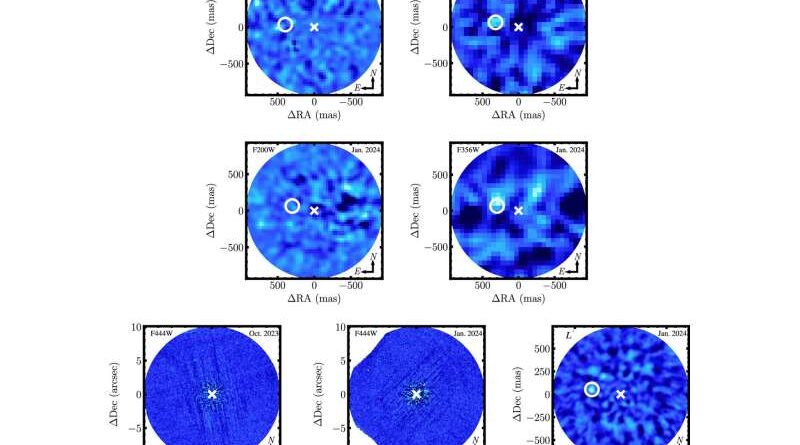Astronomers race to photograph an exoplanet near a star

Top and middle: image of F200W (left) and F356W (right) of AF Lep. AF Lep b is not detected at intensity (> 5σ) at any time. Each image is convolved with a Gaussian filter with a standard deviation of 1 pixel. The circles indicate the expected position of AF Lep b at each time. The error correlation between the coronagraphic mask and the host star for each data set is included in this statement. Bottom: left and middle panels show the full F444W AF Lep image for each sequence. There are no significant sources of detail visible in the wide distribution in this image. The artifact in the northeast of the star in the October 2023 image is “cosmic-ray” which does not appear in the 2024 January image. The right panel shows our new Keck/NIRC2 L′ image of AF Lep b. To smooth pixel-to-pixel noise, the image is convolved with a Gaussian filter with a standard deviation of 1.5 pixels. The circle indicates the expected position of the planet. AF Lep was detected with an S/N of 6.6σ. Credit: Astrophysical Journal Letters (2024). DOI: 10.3847/2041-8213/ad736a
Planet AF Lep b is the first planet. By 2023, it was the lowest-mass planet outside our solar system to be directly observed and have its mass measured using astronomy. This is a technique that shows subtle movements of a star over many years to gain information about orbiting companions, including planets.
Now, AF Lep b is the lowest-mass planet with the smallest angular separation—that is, how close it is to its star as seen from Earth—observed directly by James Webb Space Telescope (JWST). The results were announced recently on Astrophysical Journal Letters.
At 23 million years old, AF Lep b is a young gas giant. (By comparison, Jupiter is 4.6 billion years old.) This makes it brighter, and therefore, a great candidate to watch. However, a team that wanted to learn more about the planet—led by graduate students Kyle Franson of the University of Texas at Austin and William Balmer of Johns Hopkins University—had to race against the clock. to capture it. That is because it is getting closer to its star that is moving in its path. The closer it gets, the harder it will be to notice.
“AF Lep be well within the limit of being seen. Although unusually sensitive, JWST is smaller than our large telescopes on the ground,” Franson explained. “And we’re looking at longer wavelengths, which has the effect of making things look messy. It becomes difficult to distinguish one source from another when they appear to be very close together.”
In addition, JWST uses a coronagraph to detect planets near their stars. This is a device that blocks out starlight so that nearby objects can be seen. At AF Lep b’s separation from its star, the coronagraph blocks more than 90% of the planet’s light. As a planet approaches its star, more of its light will dim.
“Conventional wisdom has been that JWST has better observations of low-mass planets in wider orbits than ground-based services, but before launch, it was unclear whether it could compete with small divisions,” said Brendan Bowler, expert. UT astronomer and co-author of the study. “We’re pushing the hardware to its limits here.”
AF Lep takes about 25 years to orbit its star. Although in theory, astronomers could take a picture of it on the other side of the star when it appears again, it could be a decade before that happens.
To make sure they didn’t miss this opportunity, the team applied for—and received—Director’s Choice Time. This is a telescope time reserved for critical, time-consuming observations. It’s a competition for proposals to get screen time on JWST, and even more so under this unique name.
“This is the first Director’s Discretionary Time program led by graduate students,” said Bowler. “And it is one of the few in the field of exoplanets.”
Laurent Pueyo, an astronomer at the Space Telescope Science Center and co-author of the paper, “It’s another thing that two graduate students are able to use this great technology.”
The team was eager to learn more about AF Lep b’s orbit, as it is rare to directly observe planets as massive as gas giants in our own solar system. Based on what they observed, it has a very active atmosphere, with convection currents that mix layers between the low and high levels.
“We saw more carbon monoxide than we originally expected,” explained Balmer. “The only way to get that kind of gas into the planet’s upper atmosphere is through powerful instruments.”
While learning more about AF Lep b is fun, the ability to make these comments is very important.
“In the big picture, these data are taken in the second year of JWST operation. There are many more to come, “said Bowler. “It’s not just about the planets we know now. It also talks about the planets that we find in the near future. This foreshadows some exciting work that we will see in the coming years.”
Additional information:
Kyle Franson et al, JWST/NIRCam 4–5 μm Imaging of the Large World AF Lep b, Astrophysical Journal Letters (2024). DOI: 10.3847/2041-8213/ad736a
Offered by the University of Texas at Austin
Excerpt: Astronomers race to capture image of exoplanet near star (2024, October 9) Retrieved October 10, 2024 from https://phys.org/news/2024-10-astronomers-capture-image- exoplanet-star.html
This document is subject to copyright. Except for any legitimate activity for the purpose of private study or research, no part may be reproduced without written permission. Content is provided for informational purposes only.
#Astronomers #race #photograph #exoplanet #star
